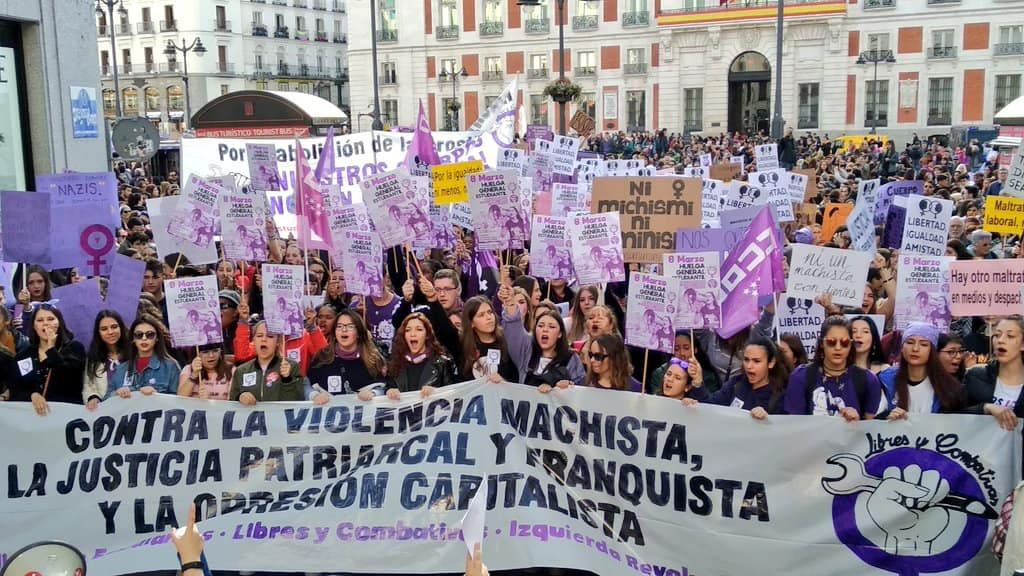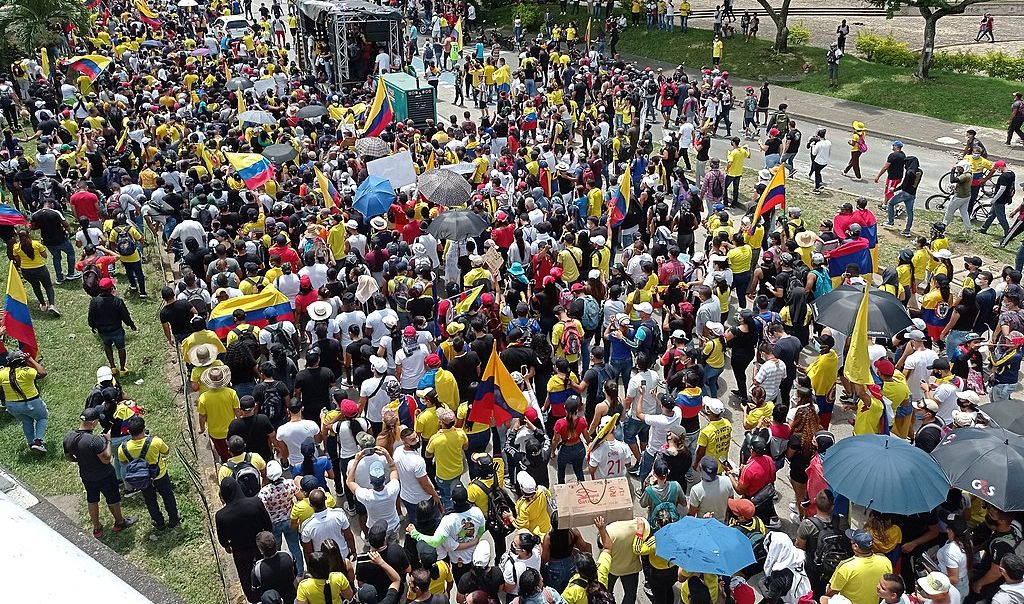Elin Gauffin is a member of Rättvisepartiet Socialisterna (CWI in Sweden).

International Women’s Day 2019 once again became a day of struggle around the world. In some countries, the movement has declined somewhat, while at the same time new movements have emerged in other countries, and in others it was bigger than ever. In Spain, the feminist strike was enormous, even larger than the last two years.
Spain
Millions of working-class women took another firm step forward, supported by hundreds of thousands of our colleagues, and we’ve held another day of strike that will undoubtedly be written in the history of the social and political struggles of the Spanish State in capital letters.
This explosion has been building, the reality of oppression, exploitation and violence against women has not been solved despite the “feminist” rhetoric of the PSOE government. There is real rage against legal system and the declarations and provocations of the reactionary and Francoist political parties, the Popular Party (PP), Ciudadanos (Cs) and Vox.
In the morning was a student strike, which was joined in the afternoon by workers striking. The morning mobilization organized by Sindicato de Estudiantes (Students’ Union) and Libres y Combativas (Free and Combative) were overwhelming: 2.5 million students on strike, and more than 400,000 in the dozens of demonstrations across all the Spanish state. These protests were so large that the bourgeois newspaper El País had the headline on its main article of the morning: “Students lead the March 8th women’s protest in the streets.”
The role of the youth on the day was crucial. Mass student demonstrations filled streets and squares at noon across all the Spanish State. In Barcelona more than 130,000 marched, while in Madrid it was more than 120,000. There were large demonstrations in almost every city.
The afternoon saw nearly seven million workers on strike. The social pressure had forced the leaders of the workers’ unions, CCOO and UGT, to extend their call for a 2 hour strike to 24 hours in different sectors, following behind the more radical unions. From early morning on March 8, the media had no choice but to highlight the swelling response of the labour strike in which nearly seven million workers participated.
The afternoon saw even larger demonstrations as workers joined the students . There was more than a million in Madrid and Barcelona and hundreds of thousands in Valencia, Bilbao, Seville, Granada, Malaga, Gasteis, A Coruña, Gijon, Valladolid and in dozens of cities. A human tide filled the demonstrations that were so massive that it was not even possible to walk.
The young students, together with our comrades, merged with millions of workers in this massive mobilisation against sexist violence, patriarchal justice and capitalist oppression. In all the demonstrations, the slogans were loud and clear: “Enough of sexist justice,” “We want to be alive, free and combative,” ‘The “Wolf Pack’ is the system,” or “Long live working class women’s struggle!”
The class composition of the movement once again made the mobilizations stand out. Again it is evident what is really the beating at the heart of this uprising — working class women.
Norway
March 8 was bigger than ever thanks to the new government’s plans to attack abortion rights. In Oslo, 14,000 marched on a demonstration which grew to 20,000 at Youngstorget. This meant that the demonstration was not just larger than at the highpoint of 2014, but also larger than at the peak of the ’70s women’s movement in 1975, which in Norway is called ”The year of the women.”
Albert Andersen Øydvin explained that it was the old women’s organizations like Kvinnofronten [Women’s Front] that arranged things but that there were a lot of young people out demonstrating and with a lot of energy. No clear message was given about how struggle can move forward but it must do so now when the government is trying to get restrictions on abortions rights passed in the parliament.
Belgium
The women’s struggle has grown gradually in Belgium. March 8 was not a particularly big day previously, but the idea a feminist strike has also grown with support from some official unions. On March 8, 10,000 took part in the demonstration in Brussels. The socialist feminist organization, ROSA, represented the largest and most vibrant block with 500 participants. In Gent, ROSA organised a demonstration with 800 people. The trade unions, CNE, CGSP and some local unions organised minor symbolic strike action. CNE had a strike call for women only (it would had been better and bigger with a strike call for all), while the other unions organized smaller and symbolic strikes for both men and women with the main demand for a €14 minimum wage.
Germany
In Germany, there was a call for a feminist strike. No major strikes took place but pressure from below led, however, to the city of Berlin announcing a public holiday and 20,000 attended the largest March 8 in a long time. Around 50,000 demonstrated throughout Germany.
Italy
All of the so-called grassroots trade unions in Italy responded to the call from the women’s movement, Non Una Di Meno, to organize strike action. Workers went on strike at hundreds of private workplaces across the country, but above all in the transport and public sectors and in the schools. For example, in Bologna, half of the city’s buses stood still.
In the evening, hundreds of thousands of people gathered in all major and minor cities against gender-based violence, against insecure employment, and against the government’s racist and anti-feminist policies. Their main anger was directed at Prime Minister Salvini.
Resistenze Internazionali, the CWI in Italy, reports that the strikes and demonstrations were both better organized and more widespread than during the previous two years.
Ireland
ROSA and the Socialist Party (CWI Ireland) campaigned for the movement that included last year’s victory on abortion rights, spontaneous demonstrations against sexist judges’ verdicts and the nurses’ strike to take a step further with work stoppages on March 8. Only one union, Unite, supported the call – but they did not mobilize for it. It was therefore more a case of symbolic strikes in some schools and universities. In Dublin, ROSA organized an hour-long blockade of the largest bridge in the city centre which was well reported in media.
Turkey
The pictures from Istanbul look as powerful as they did last year with tens of thousands or more on the streets, with demonstrations in Diyarbakir and Ankara as well. The movement against the deadly violence against women has been going on for several years, provoked by the hatred of women that Erdoğan’s government nurtures. “Feminist revolt against male violence and poverty” and “I was born free and I shall live free” were some of the slogans.
The fact that the demonstrations are so large is impressive given the strict laws that restrict freedom of expression. In Istanbul, women were brutally attacked by the police with dogs and tear gas.
Algeria
Large demonstrations also took place in Algeria and this is something new. In recent months, women have played an increasingly important role in the movement against President Abdelaziz Bouteflika who, old and in ill health, is trying to cling to power. The March 8 demonstrations in Algeria demanded freedom, democracy, dignity and an end to corruption.
Latin America
Marielle Franco, socialist and LGBT activist murdered by the far-right on March 14, 2018, was remembered this March 8 in Brazil. The workers’ and women’s struggles have been attacked by the growing right and Bolsonaro’s shocking election victory last year – which, in turn, has been answered with renewed struggle. The CWI section in Brazil, LSR, reported that tens of thousands demonstrated on March 8 in major cities such as São Paulo, Rio de Janeiro and Belo Horizonte. The main slogans were against Bolsonaro, pension reforms and violence and in memory of Marielle Franco.
The strongest women’s movement in recent years is in Latin America where struggle is constantly thrown back by new setbacks, only to pick up momentum again in the face of massive attacks and go on to win new victories. The movement against the deadly violence in Mexico has been on the rise in recent months and was also large on March 8.
The biggest newcomer when it comes to mass struggle on March 8 must be Chile. According to CNN, a 4-kilometer demonstration made its way through Santiago with 190,000 participants, well above the organizers’ expectations.
In Uruguay, it was not as big as recent years because the unions didn´t organize the strike. Still, 50,000 came to the demonstration in Montevideo. The women’s movement has won legal improvements in recent times. The main slogan now was pointed against fascism and the attacks from the right all over the continent.
The women’s movement against violence, Ni Una Menos, was born in Argentina and this year parts of the country were again stopped on March 8, as was also the case for the past two years. The demonstration in Buenos Aires was called for 5pm, but people started arriving at lunch and so many came to the demonstration that they were forced to divide up into a number of mass demonstrations that marched through the city.
The rest of the world
In many other countries around the world, there were demonstrations of varying sizes on March 8 such as in India, Britain, Serbia, Colombia, Hong Kong, Cambodia, and the US. The network that organized feminist strikes has, according to Feministiskt Perspektiv, said that there were coordinated actions in 46 countries this year. In Iran, there were many small protests – even one-person protests – on the streets by feminists who held speeches or dared to pull back their veils.
The women and the labour movements in the world proved strong on March 8, a day that historically has had a revolutionary significance. March 8 gave a good foundation for continued struggle the rest of the year.




